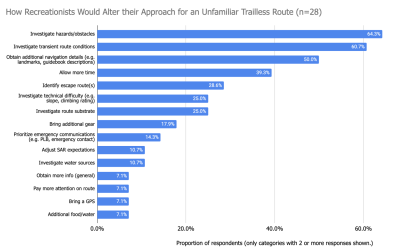fossana
Member
- Joined
- Jan 11, 2018
- Messages
- 1,057
[OK'd by Nick]
For the past few months I have been volunteering with OpenStreetMap (OSM) US' Trails Stewardship Initiative, which has been focused on southern UT. For those that aren't familiar with OSM, it's a nonprofit that hosts a crowdsourced, worldwide mapping platform. OSM's data feeds many trail apps, including CalTopo, Gaia, OnX, and AllTrails. The Trails Stewardship Initiative is a partnership between OSM, land management agencies, trail app developers, and volunteers to clarify official trails and trail access, and to improve trail routing and attributes with the aim of:
To better inform our efforts, I put together a short (5-10 min) survey on risk management for trailless routes. If you are interested in participating, here's the link.
Please have your responses in by Sunday, 28 July 2024. Thanks in advance for participating.
If you would like to learn more about the Trails Stewardship Initiative, there's an online information session on August 22nd.
For the past few months I have been volunteering with OpenStreetMap (OSM) US' Trails Stewardship Initiative, which has been focused on southern UT. For those that aren't familiar with OSM, it's a nonprofit that hosts a crowdsourced, worldwide mapping platform. OSM's data feeds many trail apps, including CalTopo, Gaia, OnX, and AllTrails. The Trails Stewardship Initiative is a partnership between OSM, land management agencies, trail app developers, and volunteers to clarify official trails and trail access, and to improve trail routing and attributes with the aim of:
- Reducing ecological and archeological impact
- Reducing SAR incidents
To better inform our efforts, I put together a short (5-10 min) survey on risk management for trailless routes. If you are interested in participating, here's the link.
Please have your responses in by Sunday, 28 July 2024. Thanks in advance for participating.
If you would like to learn more about the Trails Stewardship Initiative, there's an online information session on August 22nd.

